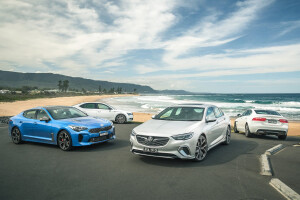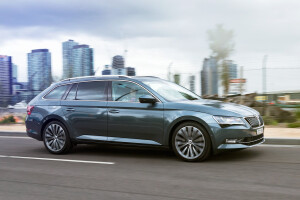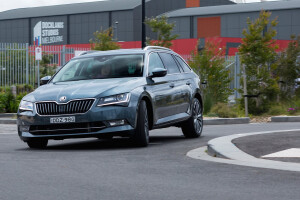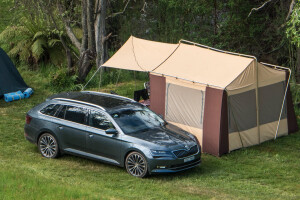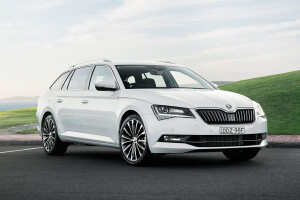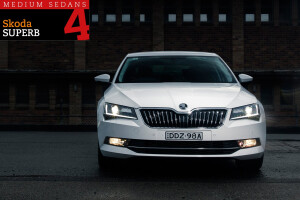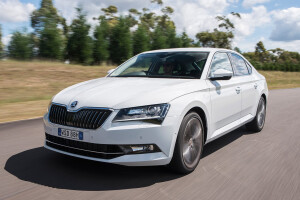Latest Review
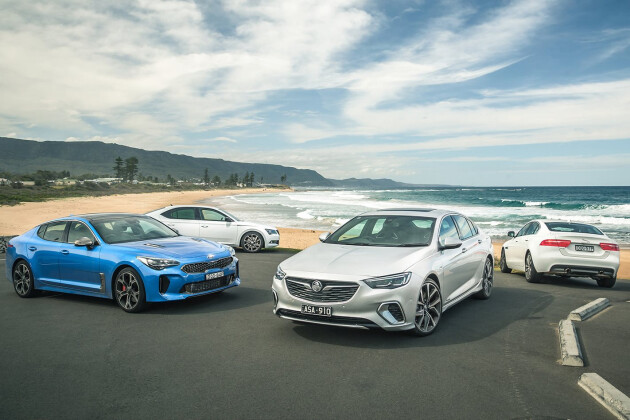
Holden Commodore VXR v Kia Stinger GT v Skoda Superb 206 TSI v Jaguar XE 25t comparison review
It's sink or swim time for the 2018 Holden Commodore ZB
There’s no hiding place here for the Holden Commodore VXR. The development vehicle excuses, the pre-launch PR bluster and any residual extended goodwill end right here.
We’ve driven pre-production versions of the ZB Commodore VXR but this is the first time we’ve pitched it in against its toughest rivals. If you’ve read the 3000km drive to Bourke and back in the February issue, you’ll know that we harboured a few reservations about this car, most specifically in the way the 3.6-litre V6 engine (which can trace its ‘High Feature’ lineage back to the 2004 VZ Commodore) interfaces with GM’s nine-speed transmission.
Given that there aren’t any normally aspirated, all-wheel drive cars in this price bracket with which to directly compare it, we’ve taken a slightly different tack. For a nominal budget of 60 to 70 grand, we’ve lined up three alternatives that tease the formula out in different directions. Looking for more grunt? The 272kW Kia Stinger GT certainly answers that call. A bit more in the way of badge equity? Look no further than Jaguar’s XE 25t. Or how about more space? The Skoda Superb Sportline 206 TSI 4x4 offers limo-like legroom and a certain low-key discretion. Game on.
If the definition of insanity is doing the same thing over and over again and expecting different results, then perhaps we have a screw or two loose. Each time we punt Holden’s Commodore VXR through the same corner, it seems to do something dissimilar. At first it’s perplexing but upon consideration, it’s apparent what’s going on. A multiplying avalanche of variables thrown at the car’s ECU by the Twinster all-wheel-drive chassis, stability-control system and nine-speed auto means that what might feel the same to us is a markedly different proposal to the VXR’s algorithm set. Hook it all up, feel the diff tweaking drive to the outside rear, the transmission plugging into four and a half grand, and it feels rock star. Miss that datum by a nanometre and you can be left with a lugging, understeering lump.
It’s never dull, that’s for sure.
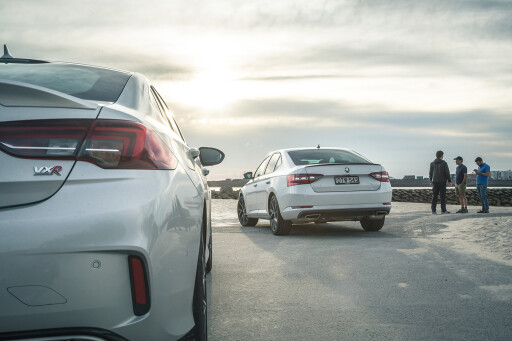 After the complexity of the $55,990 Commodore, its three rivals seem fairly straightforward propositions. None can quite match the Holden’s value-packed list price, but the $56,790 Skoda in Sportline trim comes closest. The top-spec Kia Stinger GT is priced at $59,990, and while the $56K Stinger 330Si might have been closer on price, the fact that over 80 percent of Stinger V6 buyers are choosing the flagship model swings the decision for us. Finally, there’s the Jaguar XE and a slight mea culpa. It was always going to be the outlier in this test, but we were looking to bag a $66,500 25t R-Sport model. It wasn’t available, so we’ve been left with the mechanically similar 25t Portfolio, which comes with more toys (and less sporting visuals) at a rather conspicuous $70,500 ask.
After the complexity of the $55,990 Commodore, its three rivals seem fairly straightforward propositions. None can quite match the Holden’s value-packed list price, but the $56,790 Skoda in Sportline trim comes closest. The top-spec Kia Stinger GT is priced at $59,990, and while the $56K Stinger 330Si might have been closer on price, the fact that over 80 percent of Stinger V6 buyers are choosing the flagship model swings the decision for us. Finally, there’s the Jaguar XE and a slight mea culpa. It was always going to be the outlier in this test, but we were looking to bag a $66,500 25t R-Sport model. It wasn’t available, so we’ve been left with the mechanically similar 25t Portfolio, which comes with more toys (and less sporting visuals) at a rather conspicuous $70,500 ask.
The most money also buys you the least ponies. With just 184kW under the bonnet from its turbocharged 2.0-litre Ingenium four, the Jag’s engine has that slight whiff of crippleware about it given that the ostensibly similar 30t version develops a rippling 221kW. With 137kg less than the Holden to haul and a mighty front end, Skoda’s all-wheel drive 206kW Superb might just have the cross-country chops to put some manners on the VXR. The twin-turbo Stinger is a known quantity and acts as the enthusiast’s benchmark in this class.
 The numbers that spool out of Ponchard’s data logger at Sydney Dragway are instructive. Predictably, the Kia is the quickest down the strip, but not by as much as its yawning gulf in kilowatts might suggest. On a hot and muggy day, it registers a 5.1sec run to 100km/h, breaking the quarter in 13.3sec. Next quickest is the Skoda, its 5.4sec 0-100 time helped by a combination of terrific launch control, all-wheel-drive traction and smart transmission calibration. The Commodore registers 6.2sec to 100km/h, about on par with Holden’s posted figures, while the XE’s 7.7sec result makes a mockery of its 6.3sec manufacturer’s claim. Are we lugging a makeweight in the pert shape of the British compact exec?
The numbers that spool out of Ponchard’s data logger at Sydney Dragway are instructive. Predictably, the Kia is the quickest down the strip, but not by as much as its yawning gulf in kilowatts might suggest. On a hot and muggy day, it registers a 5.1sec run to 100km/h, breaking the quarter in 13.3sec. Next quickest is the Skoda, its 5.4sec 0-100 time helped by a combination of terrific launch control, all-wheel-drive traction and smart transmission calibration. The Commodore registers 6.2sec to 100km/h, about on par with Holden’s posted figures, while the XE’s 7.7sec result makes a mockery of its 6.3sec manufacturer’s claim. Are we lugging a makeweight in the pert shape of the British compact exec?
The thousand kilometre two-day drive route ought to answer that question. Day one sees us run from Sydney over the Blue Mountains and into a massive figure-eight pivoting around Bathurst. Dynamic assessments complete, the second day sees photography duties undertaken south of Sydney on the run down to Wollongong and back, giving us the opportunity to perform interior assessments.
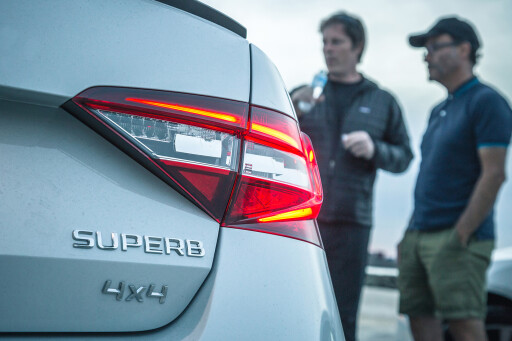 Whenever there’s a key grab, the Skoda’s is always the one that’s left. Even bedecked with spoilers and carbonfibre dash fillets, there’s still something utilitarian in appeal about the Superb, something that has you checking the rear cupholders for the complimentary spring water with every ride. It’s nevertheless fearsomely quick along a good road, and delivers impressive body control. The engine/transmission calibration is comprehensively the best of the bunch, and brake pedal feel is impressive, with a nicely ramped transition from feather to genuine bite. It’s loud though, with marked suspension thump, intrusive tyre rumble from its Potenzas, and wind noise from the front flanks where that sharply undercut bonnet scallop and swage line cleaves the air from smooth boundary layer to rustling vortices. A taciturn engine note, equally mute steering and a ridiculously high seating position undermine the Skoda’s promising dynamic potential. As rapid as it is, it feels unconvincingly developed as a performance model, lacking much in the way of reward to justify the big numbers that can appear on its clocks.
Whenever there’s a key grab, the Skoda’s is always the one that’s left. Even bedecked with spoilers and carbonfibre dash fillets, there’s still something utilitarian in appeal about the Superb, something that has you checking the rear cupholders for the complimentary spring water with every ride. It’s nevertheless fearsomely quick along a good road, and delivers impressive body control. The engine/transmission calibration is comprehensively the best of the bunch, and brake pedal feel is impressive, with a nicely ramped transition from feather to genuine bite. It’s loud though, with marked suspension thump, intrusive tyre rumble from its Potenzas, and wind noise from the front flanks where that sharply undercut bonnet scallop and swage line cleaves the air from smooth boundary layer to rustling vortices. A taciturn engine note, equally mute steering and a ridiculously high seating position undermine the Skoda’s promising dynamic potential. As rapid as it is, it feels unconvincingly developed as a performance model, lacking much in the way of reward to justify the big numbers that can appear on its clocks.
The Jaguar feels the Skoda’s polar opposite. Its chassis is clearly the fruit of engineers with a nuanced understanding of vehicle dynamics, its steering rich in feedback, its power delivery a case study in doing more with less. Even in this company, the engine feels sweet and fluid, this low-kay unit freeing up noticeably over the course of the test. Dynamically, it’s fairly easy to see where your additional outlay is going. It’s not perfect, though. The suspension feels impeccable under compression, but in rebound it can betray a lack of polish. Likewise the eight-speed ZF 8HP transmission – unusually for this ’box – can be caught on the hop with sharp throttle demands, sometimes finding itself behind the eight-ball and hurriedly making amends without its normal silky torque-converter slur.
 In certain dynamic regards the XE feels more like a Holden than the new Commodore. Its relaxed gait, the way it melds and flows with our roads, even its steering weighting smacks of VE/VF. And the rear three-quarter view has elements of VE about it, a car that Jaguar designer Ian Callum – an old work colleague of Mike Simcoe – has previously professed his admiration for.
In certain dynamic regards the XE feels more like a Holden than the new Commodore. Its relaxed gait, the way it melds and flows with our roads, even its steering weighting smacks of VE/VF. And the rear three-quarter view has elements of VE about it, a car that Jaguar designer Ian Callum – an old work colleague of Mike Simcoe – has previously professed his admiration for.
The Stinger carries nothing in the way of historical baggage. For a clean sheet, first-crack design, it’s little short of amazing. The chassis is certainly not the last word in sophistication, being the only one of the quartet that possibly wants for something in terms of torsional rigidity, but the sheer muscularity of the 3.3-litre twin-turbo V6 buys it all sorts of credit and offers the keen driver all manner of options. The eight-speed transmission doesn’t have a whole lot of head-scratching to do to make the most of a torque ‘curve’ that’s pegged at 510Nm all the way from 1300 to 4500rpm. It’s effortlessly rapid almost everywhere, although it can feel a little unwieldy when the going gets really twisty, rapid progress being an exercise in managing oversteer.
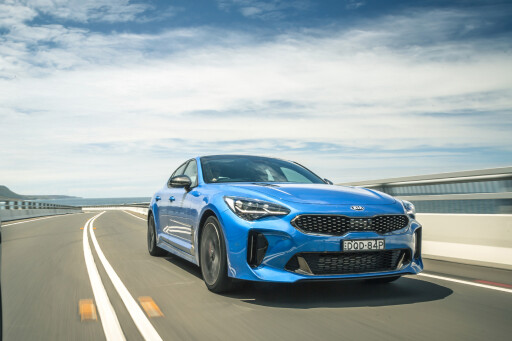 Engine aside, the Stinger’s reactions, even in its sportiest mode, are never what you’d call quicksilver. Everything has an element of slack to it. The variable-ratio steering can occasionally feel dull-witted, the throttle response is often lax, blithely knowing what’s in reserve, while the suspension, even in its firmest mode, requires you to give the car a moment for its masses to settle.
Engine aside, the Stinger’s reactions, even in its sportiest mode, are never what you’d call quicksilver. Everything has an element of slack to it. The variable-ratio steering can occasionally feel dull-witted, the throttle response is often lax, blithely knowing what’s in reserve, while the suspension, even in its firmest mode, requires you to give the car a moment for its masses to settle.
That might sound a fairly fundamental criticism, but giving the Stinger time to compose itself before any significant deviation from stasis is enough to provide some welcome reassurance. You let the car settle into a corner, and gradually feed throttle and steering.
Launch it into a change of direction with a big clog and an armful of steering and it can feel clumsy. Be a little more sympathetic with it and you can really work into a decent flow. For a car with variable-ratio electric steering, adaptive dampers, five drive modes and an eight-speed auto that can’t be locked into manual mode, the Stinger GT feels agreeably analogue.
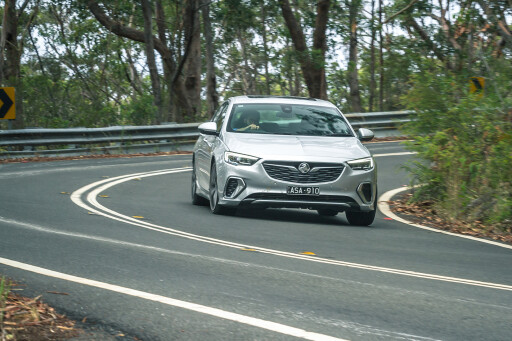 That’s one accusation you’d never level at the Commodore. It wears its tech proudly, despite being the only car here relying on old-school natural aspiration. The Twinster all-wheel-drive chassis with torque-vectoring diff, continuous damping control suspension and GF9 transmission are all clever systems in isolation. The ride quality of the VXR is well-judged and levels of ultimate grip are impressive, but that feeling of the car’s software never quite being keyed in with your own erodes confidence. The transmission’s strike rate of getting entry, mid-corner and exit correct is depressingly low. Even in racey VXR mode, we found the car upshifting at 3500rpm, well shy of the magic 4300rpm you need on board to make the car feel as if it’s up on its toes. It’s telling that peak torque arrives at 5200rpm against 2800rpm for a VFII SV6.
That’s one accusation you’d never level at the Commodore. It wears its tech proudly, despite being the only car here relying on old-school natural aspiration. The Twinster all-wheel-drive chassis with torque-vectoring diff, continuous damping control suspension and GF9 transmission are all clever systems in isolation. The ride quality of the VXR is well-judged and levels of ultimate grip are impressive, but that feeling of the car’s software never quite being keyed in with your own erodes confidence. The transmission’s strike rate of getting entry, mid-corner and exit correct is depressingly low. Even in racey VXR mode, we found the car upshifting at 3500rpm, well shy of the magic 4300rpm you need on board to make the car feel as if it’s up on its toes. It’s telling that peak torque arrives at 5200rpm against 2800rpm for a VFII SV6.
All too often, frustration then gets the better of you and you find yourself trying to shift a nine-speed ’box manually. That requires some mental adjustment, given this is a vehicle that’s revving at 3400rpm in order to maintain 100km/h in sixth whereas most cars are barely ticking over at that speed. The suspicion grows that Holden has pushed for this V6 because a Commodore range comprised entirely of four-cylinder engines would be even more unpalatable to a sceptical Australian public. Yet the torque-deficient V6 emerges as a less favourable option – from a driver’s perspective at least – than a decent turbo four; a true instance of needing to be careful what you wish for.
This fairly fundamental mismatch between engine and transmission mars what is otherwise a promising package. The spec sheet of the VXR knocks every other car here for six, making the Skoda look especially mean. Buy the Superb 206 TSI Sportline and you might well wonder what happened to niceties like a sunroof, heated rear seats and a head-up display that are standard fit on the Commodore, let alone the adaptive LED matrix headlights that do the same trick as top-line Mercedes-Benz and Audi units in keeping oncoming cars in a moving cone of dipped beam while retaining high-beam intensity elsewhere. The there’s the VXR’s Brembo brakes, 20-inch alloys, adaptive damping and premium Bose audio. Simply clever? The Skoda looks merely simple by comparison.

The Superb’s effortlessly intuitive infotainment installation knocks spots off Holden’s MyLink system, both visually and from a useability standpoint. Likewise, the rest of the Commodore’s cabin feels blue-collar made good. You don’t have to look hard to spot hard wearing, workmanlike materials. The front seats are a standout, though, with power side bolsters, a low hip point for an electrically adjustable chair, heating and cooling, as well as plenty of lateral support, albeit better at hip height than upper body. Surprisingly, the Commodore is the only one of the bunch without power assistance for the boot or tailgate, although it’s a $900 option on the Jaguar.
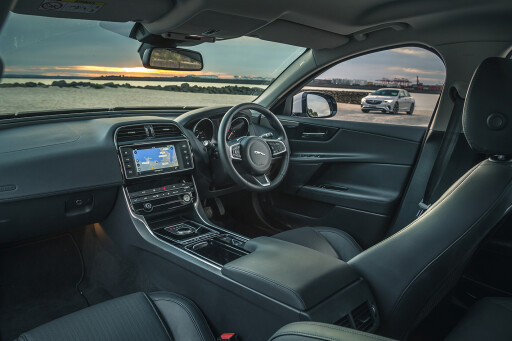 Stepping up in class and down in size, the XE’s snug cabin feels best insulated against exterior noise. While it’s not our favourite interior in the compact executive class, it nevertheless feels as if it’s accustomed to batting against higher-quality opposition than that which is arrayed here. There are some ergonomic glitches, though. The tiled centre screen isn’t the slickest, the rotating gear selector is occasionally obstructive and the giant door speakers act like cheese graters on your right knee if you’re wearing shorts and cornering enthusiastically.
Stepping up in class and down in size, the XE’s snug cabin feels best insulated against exterior noise. While it’s not our favourite interior in the compact executive class, it nevertheless feels as if it’s accustomed to batting against higher-quality opposition than that which is arrayed here. There are some ergonomic glitches, though. The tiled centre screen isn’t the slickest, the rotating gear selector is occasionally obstructive and the giant door speakers act like cheese graters on your right knee if you’re wearing shorts and cornering enthusiastically.
You expect the rear seat to be tight in the XE but it makes the most of available space, with cut-outs on the backs of the front seats and enough clearance to nestle your toes under the front chairs. The baby Jag is actually 6mm longer in wheelbase than the Commodore, but Holden has worked the ball of foot to front-wheel ratio rather cleverly, extending the passenger cell accordingly. Rear headroom in the Jaguar isn’t bad either, and the XE surprises again by being almost as wide as the Holden and Skoda, despite being the shortest of the bunch by over 100mm.
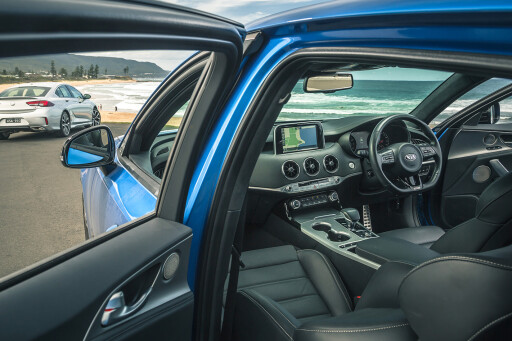 Although you’d swear the Kia was the widest, the longest and the lowest, it concedes overall length to both the Holden and Skoda. The Stinger’s cabin feels conspicuously well screwed together and endowed with a degree of design flair. Yes, it’s fun to play the game of picking where Kia has cribbed its ‘design influences’ from, but it all seems to gel reasonably well. Apart from the coarsely grained steering-wheel boss. That needs to go come facelift time.
Although you’d swear the Kia was the widest, the longest and the lowest, it concedes overall length to both the Holden and Skoda. The Stinger’s cabin feels conspicuously well screwed together and endowed with a degree of design flair. Yes, it’s fun to play the game of picking where Kia has cribbed its ‘design influences’ from, but it all seems to gel reasonably well. Apart from the coarsely grained steering-wheel boss. That needs to go come facelift time.
The Stinger is generously equipped too, to the extent that our test car didn’t have a single extra-cost option fitted to it. Our Micro Blue GT is exactly what you’d get if you walked into the dealer, handed over the minimum agreed amount and drove away. And, to be honest, you’re not left wanting.
Arriving at a finishing order for these four isn’t easy, though deciding on the top two and bottom two didn’t tax us for too long. The Skoda washes up an honourable fourth. It’s a genuinely rapid vehicle on almost any road you could imagine but at this price point it’s just too sparsely equipped and anodyne. It never feels either convincingly sporty or particularly good fun, which condemns it to the wooden-spoon position in this quartet. It’s spacious and easy to live with, but saving $5K and landing the non-Sportline version would bolster the Superb 206 TSI 4x4’s Q-car credentials.
The Commodore VXR finishes third. Its gearbox and engine combination are a disappointment. Factor in fuel consumption that was markedly the worst on test, underwhelming exterior styling and a cabin that has a little too much of a toner cartridge sales rep feel about it and even its clever chassis tech, astonishing kit list and generous accommodation can’t salvage its chances. That said, we suspect that the VXR is a weak link in the current Commodore line-up. Would this position have changed with a 250kW torque-rich turbo four beneath the bonnet? In all likelihood, yes.
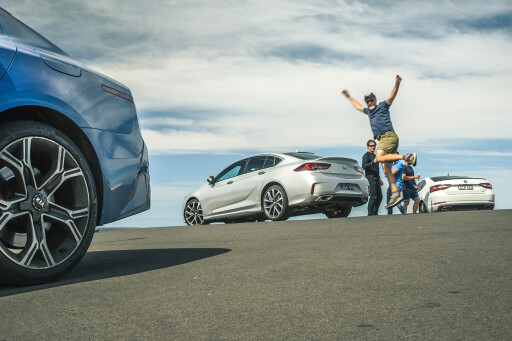 Splitting the Jaguar XE 25t Portfolio and the Kia Stinger GT will probably come down to whether you value a certain considered touch and tactility, or whether you just want to mash the nuclear button with your fist. We adored the subtlety of the Jaguar, its poise and sweetness of response, but as Mike Tyson once said, everyone has a plan until they get punched in the mouth.
Splitting the Jaguar XE 25t Portfolio and the Kia Stinger GT will probably come down to whether you value a certain considered touch and tactility, or whether you just want to mash the nuclear button with your fist. We adored the subtlety of the Jaguar, its poise and sweetness of response, but as Mike Tyson once said, everyone has a plan until they get punched in the mouth.
The big hitter of the group also has other qualities aside from its power advantage. Its seven-year warranty can’t be overlooked, and nor can the fact that to specify an XE to anywhere near the Kia’s level would probably see the final invoice running to six figures. So we’re going Stinger. And the Commodore VXR? It puts in a big effort and offers an interesting blend of talents but, in this company at least, feels unresolved in its execution. Nice try, but it’s a swing and a miss for us.
News
-
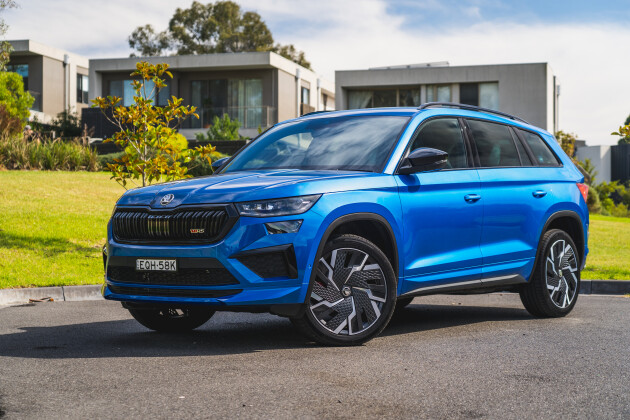 News
NewsSkoda's potential 15,000 sales thwarted by 2022 supply crisis
The Czech brand's performance has suffered heavily during the last two years
-
 News
News2022 Skoda Octavia, Superb and Kodiaq recalled
The issue presents a fire risk to occupants and bystanders
-
 News
NewsSkoda Superb joins Western Australia Police
The Skoda Superb becomes the latest European model to take on police duties in Australia with the likes of the BMW 5 Series and Volkswagen Passat
-
 News
NewsAustralia's fastest-selling cars revealed
We reveal the vehicles that are growing sales the quickest in Australia – and there isn’t a Toyota in sight
-
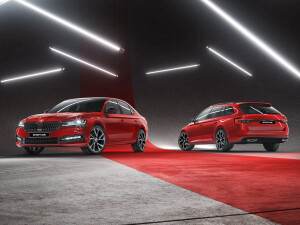
2021 Skoda Superb price and features
-

Which car should I buy: family wagon for $30,000
-
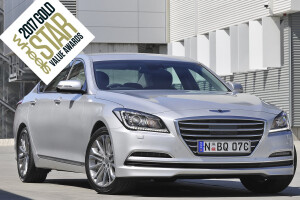
Large under $65K: Australia’s Best Value Cars 2017
-
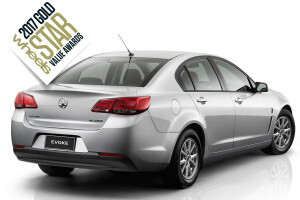
Large under $45K: Australia’s Best Value Cars 2017



